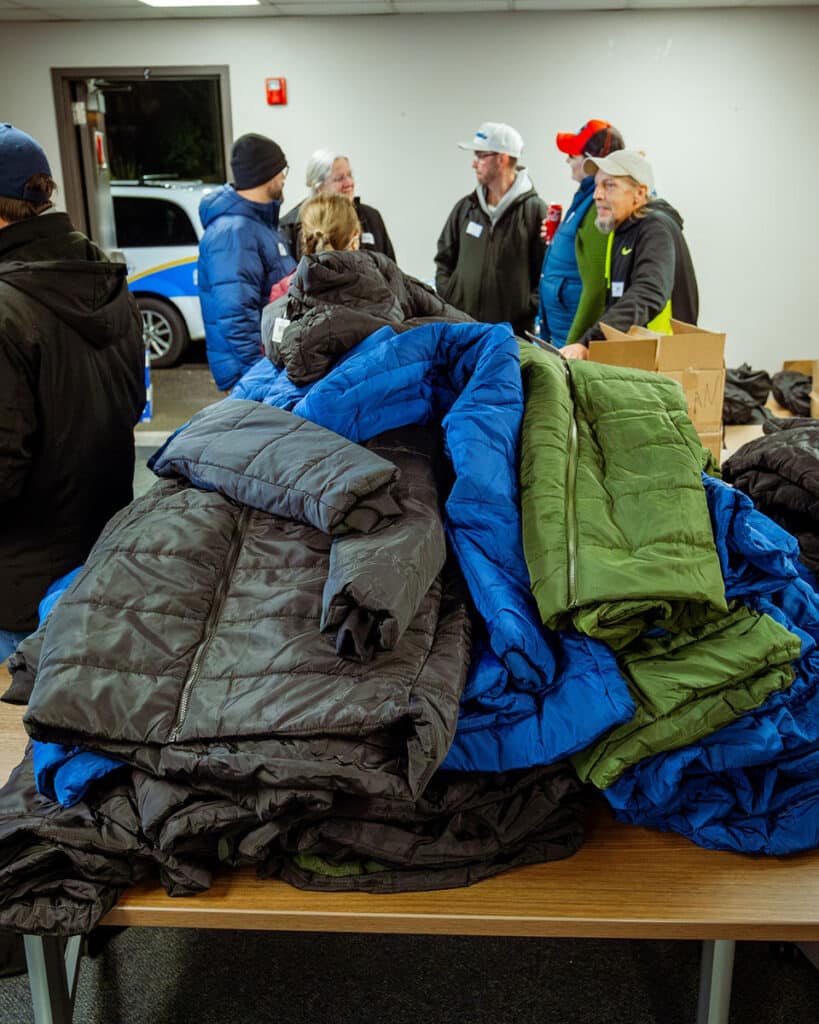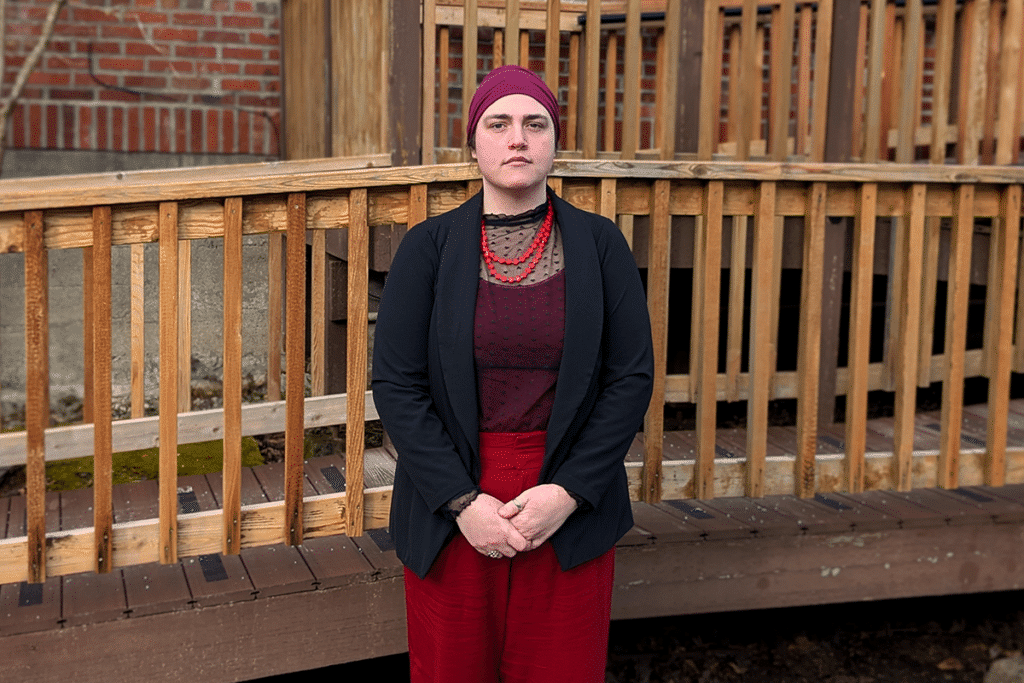Community Health & Wellness
Volunteers gather to count the peninsula’s hard-to-find homeless population
Delci Whited gets out of her Ford Fusion and walks through a vacant parking lot in Gig Harbor. She heads towards the bushes at its edge.
Community Sponsor
Community stories are made possible in part by Peninsula Light Co, a proud sponsor of Gig Harbor Now.
There does not appear to be anyone here, so she calls out: “Anybody home?” Silence. She tries again: “Key Peninsula Community,” she says, naming the organization where she works as a housing and homeless program manager. Still nothing. Whited and three others wade into the bushes, confirming no one is sleeping behind them.
It is after 9 p.m. Whited and three others have been driving the Highway 16 corridor near Gig Harbor for about an hour, searching in the rain and frigid temperatures for people experiencing homelessness.
The group are among the hundreds of volunteers participating in Pierce County’s Point-in-Time Count, a single-day event that tries to estimate the number of people who are homeless. They have found a few encampments, leaving behind supplies in case anyone returns, but no people thus far.
An imperfect process
Before the night count begins, as group members make introductions, a volunteer who asked not to be identified tempers expectations.
“We may not find anyone tonight,” he says.
Getting a reliable count of people experiencing homelessness is difficult anywhere. On the Gig Harbor-Key Peninsula — with its dense woods even in the most urban areas and sprawling parking lots — it is even more arduous. The unhoused population is more likely to lead solitary lives here. They take shelter in the woods, vehicles or abandoned structures. Providers say that can make it easier for the community to deny their existence.
Yet every night, about a couple dozen people are experiencing homelessness on the peninsula. Over the last year, providers have made new investments to serve this often neglected demographic.
During last year’s Point-In-Time Count, volunteers identified 25 people, including 17 in Gig Harbor, who were homeless, according to the Pierce County Human Service Department.
That is likely an undercount. The federal government mandates the Point-In-Time Count and ties its results to policy and funding decisions. But critics call the process important but flawed. People need to be either seen by a volunteer or report to a designated location to be tallied.
Whited said Key Peninsula Community Services alone put 30 intake forms into the Homeless Management Information System, a portal the county uses to collect client-level data on those experiencing homelessness.
“I’m not a data scientist,” she said, “but the PIT Count is not good data.”
Gig Harbor's homeless population
It is also unclear how many people are experiencing homelessness within Gig Harbor’s city limits specifically. During their search, volunteers come across several encampments near the Uptown neighborhood.
City officials report interacting with those experiencing homelessness regularly. Police Chief Kelly Busey said officers typically encounter them about once or twice a week. Some live in known campsites in the area, while others sleep in cars, he said.
Busey was unable to provide more specific numbers, deferring to the Gig Harbor-Key Peninsula Homelessness Coalition. A spokesperson for the coalition did not return multiple calls and messages seeking an interview.
Police are often the first people to come in contact with unhoused people in Gig Harbor. If there’s no criminal element involved, officers may involve Shea Smiley, the city’s housing, health and human services manager.
In December, for example, the city parks department notified her about someone living on a city-owned conservation area. Smiley helped them get placed at a shelter in Tacoma. It is one of the dozens of people she’s helped access services.
More time to spend
Police previously responded to individuals experiencing homelessness in a similar way, but because of the emergent nature of their work they were unable to spend much time building relationships, said City Administrator Katrina Knutson.
“With the addition of Shea, we’ve been able to see more movement into shelter or temporary supportive housing because she has those connections,” Knutson said. “The police have always done a great job. It's just now that we're able to provide a little bit more resources, a little bit more time. I think we're seeing more success.”
Smiley, hired in October partially using opioid settlement dollars, is the first employee at the city dedicated specifically to social services needs like housing. Her position was created to help meet some unique needs for vulnerable groups in Gig Harbor.
In an email to Gig Harbor Now, Smiley said that every week she works with “numerous people” experiencing homelessness or on the verge of becoming homeless. Asked for an estimate of the city’s homeless population, she referred to last year’s PIT Count.

As part of the Point-In-Time Count, volunteers hand out jackets and other supplies to people experiencing homelessness. Photo courtesy Pierce County
New city policy planned
Beside outreach, Smiley has also worked to update city policy around homelessness. In December, she drafted an internal framework clarifying how each department would respond to reports of individuals experiencing homelessness.
“While we don’t have necessarily an overwhelming issue with homelessness in Gig Harbor, we do have individuals experiencing homelessness,” she told the City Council during a December meeting. “We wanted to ensure risk mitigation and be compassionate and consistent in how we respond to individuals experiencing homelessness.”
The city is also considering additional protections for tenants and an amendment to its code that would prevent overnight camping on city owned properties, including stormwater facilities and conservation areas. Right now, those codes only extend to parks.
Knutson said the city does not plan to do sweeps. City leaders prefer a proactive approach that offers support and services to every individual they become aware of.
“We believe by doing this that we’re not ignoring the problem and letting anything quote unquote get out of hand,” she said. “We’re addressing it as it happens. We believe that that’s a compassionate way to move forward.”
Key Peninsula
New investments are also being made on the other side of the Purdy bridge. Key Peninsula Community Services, a senior center and food pantry located near Home, launched an homelessness outreach program last fall.
Executive Director Willow Eaton says the program – created through a $175,000 grant from Pierce County – was the first funding awarded specifically targeting people experiencing or at risk of homelessness on the Key Peninsula. Thus far, it has been “far exceeding” expectations.
The agency has hired a program manager and outreach assistant. They go out into the community, often in response to residents' calls, and develop a relationship with homeless individuals. Although clients may be reluctant to accept things like housing or substance abuse treatment, they will rarely turn down a meal or other supplies, Eaton said.
“We do talk about those [other] options, but we're not there to say, this is what you're gonna do,” she said. “Through creating that relationship, which is what it’s all about, and getting them to trust our outreach personnel, hopefully we can get an inroad to helping them into a sustainable situation.”
Challenges for providers
Getting homeless individuals into housing or providing any kind of services can be difficult out on the Peninsula. The population is scattered over a large area and connected by little-to-no public transit.
When freezing temperatures rolled in during the last weeks of January, few people ended up taking refuge at the community’s designated warming center. Chapel Hill Church on Skansie Avenue in Gig Harbor opened up its lobby as a warning center from 7:30 a.m. to 9 p.m. for a total of eight days in the last two weeks of the month to get people out of the cold.

Pierce County Executive Ryan Mello talks to volunteers during the Point-In-Time Count. Photo provided by Pierce County.
Judson Taylor, the church’s director of communications, said they had “about two” individuals over the first four days they were open. There is no definite reason for the low turnout, but limited mobility is likely a contributor.
Resources for housing are also extremely limited on the Peninsula. The area has no congregate overnight shelter and officials do not foresee one getting built anytime soon.
“That’s going to be outside of my tenure,” said Eaton, the KPCS executive director. “I think that it would be successful, but I don’t see anybody right now in the pipeline saying ‘oh yeah, we want to do that.”
The absence of any overnight shelter on the peninsula presents a barrier to getting people into housing, she said. KCPS places few people into overnight shelters because nearly all options are in Tacoma. Most people living out here do not want to leave the Key Peninsula, she said. “It's their home.”
Staying in a community they know
Safety and familiarity are major reasons behind that.
Being homeless is inherently vulnerable. Those who are unhoused are at an increased likelihood of being the victim of violent crime, according to the Washington Low Income Housing Alliance. Many opt for a solitary existence on the Peninsula over an unfamiliar and crowded shelter.
“For many of these people, the idea of going to Tacoma is overwhelming and even frightening,” said Robyn Denson, the Pierce County Council member who represents the Peninsula. “It’s an unfamiliar landscape where they know no one.”
Denson says “the grand majority” of people homeless on the Peninsula lived there before they became homeless. It is a myth that people come to the area to be homeless, she said. People who end up homeless on the peninsula are more likely to go to Tacoma in pursuit of housing or other resources.
“Most would prefer to stay in their community if they can,” she said. “They grew up here and this is what they know.”
Not only a Tacoma problem
While not referring to the peninsula specifically, Rob Huff, a spokesperson for the Tacoma Pierce County Coalition to End Homelessness, said communities around the region often do not want to deal with homelessness. Instead, they prefer to send unhoused individuals to the city. Even those living outside Tacoma are often being served by providers from the city, he said.
“One of the primary focuses of the coalition has been to have all of our communities across the county focus on actual solutions,” he said. “The creation of more shelter, creation of programs in places where people already are homeless — that will help folks to emerge from homelessness.”
There is a need for housing options to serve those outside of Tacoma, particularly for parents with children, Denson said. Creating such a facility would be difficult. Zoning regulations make placing a shelter outside Tacoma challenging and a large shelter likely wouldn’t be particularly effective on the peninsula.
Denson there is a place for large, communal shelters, particularly in urban areas with needs for lots of beds. But these facilities are not the best practice in most communities. Small apartments or tiny homes would be preferable and would be more likely to get people in Gig Harbor or the Key Peninsula to accept housing placements.
“These types of housing give individuals and families more security and privacy and best prepare individuals and families to transition into permanent independent housing,” she said.
‘It’s a small thing’
The night count ends near Purdy after 11 p.m. The volunteers come across several empty encampments during their three hour search. They see only one person: A middle-aged man living in his RV in Gig Harbor who says through his window that he has been homeless for over a decade.
The results for the count are not yet official but, Whited said she was aware of seven people found between the overnight search and a day-time event where individuals could self-report. It hardly reflects the size of those experiencing homelessness.
Whited, who grew up partially on the Key Peninsula, says regularly she sees a group of people sleeping in vehicles on her street. Although she has been in her position since October, and now serves over 40 clients, she says there is a longer feeling that she has only scratched the surface.

Delci Whited, Housing and Homeless Program Manager for Key Peninsula Community Services. Photo by Conor Wilson
Thus far, she has helped one person into housing. Often all she can do for her client is offer them a jacket or hand warmers, making them more comfortable and keeping them alive while she looks for more sustainable options and develops a rapport with them.
At times, given the scope of problems her clients face, offering something as small as hand warmers can feel insulting, she says. She has to remind herself that those things, while not life changing, make a difference. Before being hired there was probably no one even acknowledging the person’s existence.
“It’s a small thing,” she says. “But I know it’s important.”

